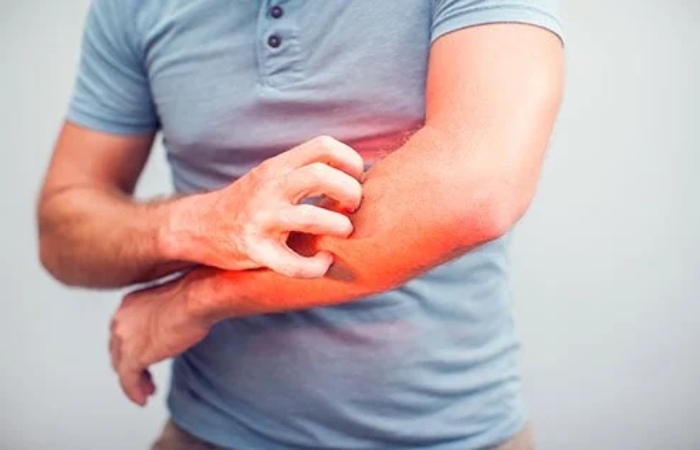Share This Article
Introduction
A skin allergy is an ailment in which the skin becomes irritated due to a reaction of the immune system to something usually harmless. It is called an allergic reaction. An allergic answer can reason rash, itching, burning, redness, bumps, hives, and inflammation. Many different allergens can cause a reaction. Below are some of the more common allergic skin conditions:
Different Skin Allergy

- Atopic dermatitis (dur-much-that-this), or eczema, is when the skin develops easily irritated, itchy, and dry. It is the most common allergic skin state and is more joint in children than adults. Eczema is related to genetic (inherited from parents) and conservation factors. For example, asthma does associate with food allergies and seasonal allergies. In addition, certain things, such as certain foods, stress, soaps, lotions, or cold, dry air, can cause eczema to flare up.
- Allergic contact dermatitis is when something bites the skin and causes a reaction. For example, some people are allergic to metallic nickel and will have a skin response if jewelry made with nickel comes into contact with their skin. The reaction to poison ivy is another example. Many people are allergic to oil derived from the poison ivy or poison oak plant.
- Hives (ur-ti-air-ee-uh) or hives are bumps caused by Skin Allergy. These bumps are also called welts or hives. For example, a person can get hives after eating an allergic food. The lumps result from histamine that the body issues in response to the allergen. Things other than allergies can also cause hives, such as insect bites.
- Angioedema (an-jee-oh-i-dee-much) is deep swelling of the skin. It usually occurs in places such as the eyelids, lips, and throat and often with a hello.
Symptoms of Skin Allergy
Symptoms of a skin Allergy vary conditional on the type of reaction:
- Eczema causes a dry, red, scaly, itchy rash, especially on the face, hands, elbows, and knees. Every so often, eczema also discharges a clear liquid.
- Allergic contact dermatitis causes a rash that can be itchy but often painful. The inflammation can have both bumps and blisters. The reaction can happen immediately or take up to 48 hours after your skin does expose to whatever caused the reaction.
- Hives raised flat, itchy bumps that can tend. Hives are a sign of a potentially severe Skin Allergy.
- Angioedema is a type of swelling. For example, angioedema of the eyelid can cause the eye to swell and close. When it occurs in the throat, the node is an emergency as it makes breathing difficult.
When to See a Doctor
Hives and angioedema may be symbols of a severe Skin Allergy. Call 911 or go to the emergency apartment if: He has hives all over his body. You begin to have difficulty breathing. See a doctor if you need help managing your eczema, impulsive bleeding, yellowish pus, and appearance like it’s infected. You reason you may have an allergy you didn’t have before; you have a skin impulse that does not heal after 2 to 3 weeks.
Causes of Skin Allergy
A skin Allergy is an ailment in which the immune system reacts strongly to an allergen. The reaction may cause irritation, outbreaks, swelling, or hives. The reason for the Skin Allergy depends on the situation and the allergen.
Diagnosis and Tests Skin Allergy
To diagnose an allergic skin condition, your doctor may:
- Ask questions about your skin, the symptoms you have, and when it happened.
- Examine your skin. The doctor may also examine your eyes, nose, throat, and chest for signs of allergies.
Suggest Allergy Tests: Skin Allergy
- Skin prick test. If the doctor responds you may be allergic to something, they will dab a little on your skin and gently scratch it. If your body does react, you’ll usually have a rash, rash, and itching within 15 minutes. You can also see a beehive. It indicates allergies, especially if the hive is large. Of course, your skin can be irritated by things you’re not allergic to, so a skin prick test is only part of the information for you and your doctor. Even if your skin does react, it doesn’t necessarily mean you have an allergy.
- Skin examination (subcutaneous). This test is to use if the skin puncture did not cause a reaction, but the doctor still responds you have an allergy to this test. A doctor or nurse injects some allergens into your skin and checks a response after a specific time.
- Blood tests (specific IgE). The doctor takes a blood sample and sends it to the lab. The lab will put the suspected allergen in your blood and check for the IgE your blood produces to attack the allergens. Unfortunately, this test is not always consistent because it often indicates that an allergy is present when it is not. It is called a “false positive.”
And More
- Challenge test. While in the doctor’s office, inhale or eat a small amount of the allergen so the doctor can see if you are reacting. The doctor is there to monitor and help if you have a life-threatening reaction—this test detects allergic reactions to foods or drugs.
- Patch test. This test looks for allergic contact dermatitis. The doctor applies a small amount of allergen to your skin, wraps it in a bandage, and leases it to sit for 2 to 4 days. Then, the doctor will check for signs of a reaction, which is usually a rash just under the bandage.
Conclusion
The best way to prevent skin allergy reactions is to find out which allergen is causing the reaction and avoid it. Consider potential allergens that get directly on the skin, such as soaps, shower gels, hair products, makeup, lotions, and creams. Foods and pills can also cause allergic reactions, especially hives and swelling.


